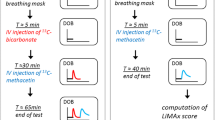Abstract
According to the theoretical pharmacokinetical considerations put forward by Wehner et al. the BACven/BrAC conversion factor Q is not a constant value and varies depending on the pharmacokinetic phase deduced from the alcohol concentration curve. Based on these considerations we propose that Q must be inversely proportional to the BrAC during the postabsorptive linear elimination phase, expressed as the hyperbola Q=1/κ+(CT)/BrAC. The constants κ or 1/κ and (CT)—where (CT) consists of different parameters which remain constant during the linear elimination phase—can be experimentally determined from the linear relationship BrAC=κBACven−κ(CT). To test this hypothesis 12 human volunteers received parenteral doses of ethanol. During the elimination phase, BAC and BrAC of each volunteer were measured between 18 and 34 times in a BrAC range between 0.65 mg/l and 0.12 mg/l. The conversion factor Q was either expressed in the form of the hyperbola Q=1/κ+(CT)/BrAC or directly calculated from the ratio BACven/BrAC and the results obtained using both methods were found to be very similar. The values of 1/κ of the hyperbolic functions varied between 1.808 and 2.165 and those of (CT) between 0.004 and 0.127. For a BrAC of 0.25 mg/l, an average value of 2.308±0.080 could be calculated for the conversion factor Q0.25. On average, the value of Q0.40 amounted to 2.207±0.048 and that of Q0.55 to 2.160±0.056.



Similar content being viewed by others
References
Brackemeyer U, Schoknecht G (1997) Ergebnisse einer Erprobung der beweissicheren Atemalkoholanalyse im polizeilichen Einsatz. Die Polizei 12:345–355
Dubowski KM (1979) The blood/breath ratio of ethanol. Clin Chem 25:1144
Dubowski KM (1986) Recent developments in alcohol analysis. Alcohol Drugs Driving 2:13–46
Gilg T, Priemer F, Jocham N, Eisenmenger W (2000) BAK/AAK-Quotienten in verschiedenen Alkoholisierungsphasen—Untersuchungen mit dem Dräger Evidential 7110 bei 20 Trinkversuchen. Rechtsmedizin 10 [Suppl 1]:6
Graw M, Haffner HT (2003) Berechnungsmodell für intraindividuel-situative BAKven/AAK-Konversionsfaktoren Q in der postresorptiven Eliminationsphase—Vorschlag für ein standardisiertes Verfahren zur Gewinnung vergleichbarer experimenteller Ergebnisse. Blutalkohol 40:1–4
Gullberg RG (1990) An application of probability theory to a group of breath-alcohol and blood-alcohol data. J Forensic Sci 35:1342–1352
Gullberg RG (1991) Statistical evaluation and reporting of blood alcohol/breath ratio distribution data. J Anal Toxicol 15:343–344
Haffner HT, Graw M, Jeske A, Schmitt G, Goll M, Dietz K (2002) Die Präzision von Atemalkohol (AAK)-Messungen mit dem Dräger Alcotest 7110 Evidential im Vergleich zur Präzision der forensischen Blutalkohol (BAK)-Bestimmungen. Blutalkohol 39:397–406
Jachau K, Schmidt U, Wittig H, Römhild W, Krause D (2000) Zur Frage der Transformation von Atem- in Blutalkoholkonzentrationen. Rechtsmedzin 10:96–101
Jones AW (1978) Variability of the blood:breath alcohol ratio in vivo. J Stud Alcohol 39:1931–1939
Jones AW, Andersson L (1996) Variability of the blood/breath alcohol ratio in drinking drivers. J Forensic Sci 41:916–921
Jones AW, Beylich KM, Bjørneboe A, Ingum J, Mørland J (1992) Measuring ethanol in blood and breath for legal purposes: variability between laboratories and between breath-test instruments. Clin Chem 38:743–747
Jones AW, Andersson L, Berglund K (1996) Interfering substances identified in the breath of drinking drivers with Intoxilyser 5000S. J Anal Toxicol 20:522–527
Köhler H, Banaschak S, Brinkmann B (1997) AAK-BAK-Vergleichsuntersuchungen mit dem "beweissicheren" Alcotestgerät 7110 Evidential. Blutalkohol 34:36–44
Köhler H, Beike J, Abdin L, Brinkmann B (2000) Fehlerhafte Atemalkoholmessung? Eine Massenstudie mit dem Alcotest 7110 MK III Evidential. Blutalkohol 37:286–292
Labianca DA, Simpson G (1996) Statistical analysis of blood- to breath-alcohol ratio data in the logarithm-transformed and non-transformed modes. Eur J Clin Chem Clin Biochem 34:111–117
Lagois J (2000) Dräger Alcotest 7110 Evidential—das Meßgerät zur gerichtsverwertbaren Atemalkoholanalyse in Deutschland. Blutalkohol 37:77–91
Martin E, Moll W, Schmid P, Dettli L (1984) The pharmacokinetics of alcohol in human breath, venous and arterial blood after oral ingestion. Eur J Clin Pharmacol 26:619–626
Mason MF, Dubowski KM (1976) Breath-alcohol analysis: uses, methods, and some forensic problems—review and opinion. J Forensic Sci 21:9–41
Schoknecht G (1992) Beweissicherheit der Atemalkoholanalyse. Gutachten des Bundesgesundheitsamtes. Unfall- und Sicherheitsforschung Straßenverkehr 86 Wirtschaftverlag NW, Bremerhaven
Schuff A, Riepert T, Erkens M, Weirich V, Graß H, Iffland R (2002) Untersuchungen zum Quotienten BAK/AAK in der Resorptionsphase und dessen Bedeutung für die Wartezeit bei der Atemalkoholmessung. Blutalkohol 39:145–153
Wehner HD, Wehner A, Subke J (2000) Die Genauigkeit des veno-alveolären Ethanolkonzentrationsquotienten. Blutalkohol 37:18–29
Wilkinson PK, Rheingold JL (1981) Arterial-venous blood alcohol concentration gradients. J Pharmacokinet Biopharm 9:279–307
Wittig H, Schmidt U, Jachau K, Römhild W, Krause D (2000) Beeinflussung des BAK/AAK-Quotienten durch verschiedene Umgebungstemperaturen. Blutalkohol 37:30–38
Wolf M, Wiens N (1982) Zum Verlauf der Blutalkoholkurve im niedrigen Konzentrationsbereich. Beitr Gerichtl Med 40:63–67
Author information
Authors and Affiliations
Corresponding author
Additional information
H.T. Haffner and M. Graw have contributed equally to the manuscript.
Rights and permissions
About this article
Cite this article
Haffner, H.T., Graw, M., Dettling, A. et al. Concentration dependency of the BAC/BrAC (blood alcohol concentration/breath alcohol concentration) conversion factor during the linear elimination phase. Int J Legal Med 117, 276–281 (2003). https://doi.org/10.1007/s00414-003-0384-5
Received:
Accepted:
Published:
Issue Date:
DOI: https://doi.org/10.1007/s00414-003-0384-5




